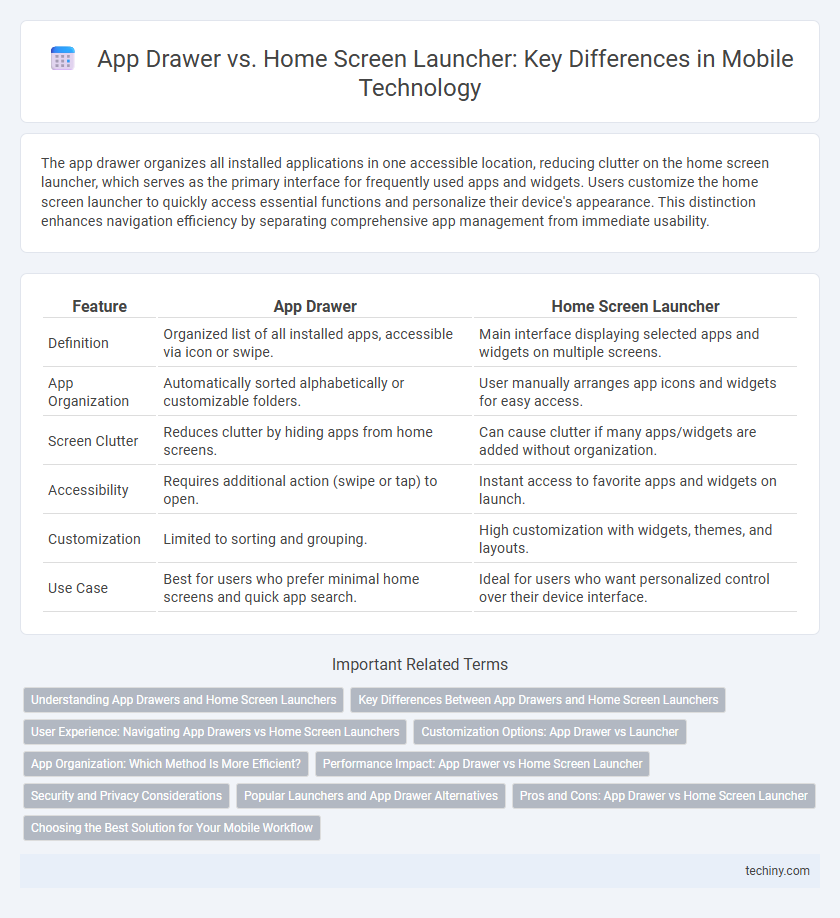The app drawer organizes all installed applications in one accessible location, reducing clutter on the home screen launcher, which serves as the primary interface for frequently used apps and widgets. Users customize the home screen launcher to quickly access essential functions and personalize their device's appearance. This distinction enhances navigation efficiency by separating comprehensive app management from immediate usability.
Table of Comparison
| Feature | App Drawer | Home Screen Launcher |
|---|---|---|
| Definition | Organized list of all installed apps, accessible via icon or swipe. | Main interface displaying selected apps and widgets on multiple screens. |
| App Organization | Automatically sorted alphabetically or customizable folders. | User manually arranges app icons and widgets for easy access. |
| Screen Clutter | Reduces clutter by hiding apps from home screens. | Can cause clutter if many apps/widgets are added without organization. |
| Accessibility | Requires additional action (swipe or tap) to open. | Instant access to favorite apps and widgets on launch. |
| Customization | Limited to sorting and grouping. | High customization with widgets, themes, and layouts. |
| Use Case | Best for users who prefer minimal home screens and quick app search. | Ideal for users who want personalized control over their device interface. |
Understanding App Drawers and Home Screen Launchers
App drawers organize all installed applications in a centralized, scrollable list, enhancing accessibility without cluttering the home screen. Home screen launchers customize the device interface by allowing users to add app icons, widgets, and shortcuts for frequently used applications. Understanding the distinction between these two components is essential for optimizing navigation efficiency and personalizing user experience on mobile devices.
Key Differences Between App Drawers and Home Screen Launchers
App drawers organize all installed applications in a centralized, scrollable grid or list, enhancing app discoverability without cluttering the home screen. Home screen launchers display app icons, widgets, and shortcuts directly on multiple home panels, allowing for quick access and customization tailored to user preferences. The primary difference lies in app accessibility: app drawers separate the full app list from the home interface, while launchers integrate apps and widgets for immediate interaction.
User Experience: Navigating App Drawers vs Home Screen Launchers
Navigating app drawers offers users a structured and comprehensive view of all installed applications, enhancing discoverability and organization within mobile technology environments. Home screen launchers prioritize quick access with customizable widgets and shortcuts, streamlining frequent task execution and improving overall efficiency. User experience benefits from balancing the extensive app catalog in drawers against the personalized, immediate utility provided by home screen launchers.
Customization Options: App Drawer vs Launcher
App drawers offer a streamlined approach by organizing all installed applications in a single, searchable menu, enhancing ease of access without cluttering the home screen. Home screen launchers provide extensive customization options, allowing users to arrange widgets, shortcuts, and app icons freely, personalize themes, and apply icon packs for a tailored experience. Popular launchers like Nova Launcher and Microsoft Launcher excel in customization, surpassing the limited organizational features of default app drawers.
App Organization: Which Method Is More Efficient?
App drawer and home screen launcher serve distinct roles in mobile app organization, with app drawers offering a centralized space to access all installed apps alphabetically or by category, reducing clutter on the home screen. Home screen launchers prioritize quick access by allowing users to place frequently used apps as icons or widgets, enabling personalized layouts but potentially causing disorganization if overused. Efficiency depends on user preference for either streamlined app discovery via app drawers or instant availability through home screen launchers.
Performance Impact: App Drawer vs Home Screen Launcher
The app drawer typically consumes fewer system resources than the home screen launcher, resulting in faster device performance and smoother multitasking. Home screen launchers often preload widgets and live wallpapers, which can increase CPU and memory usage, causing potential slowdowns. Efficient memory management in app drawers enhances battery life and reduces lag compared to resource-intensive home screen launchers.
Security and Privacy Considerations
App drawers provide enhanced security by segregating installed apps from the home screen, reducing accidental access and minimizing exposure to sensitive applications. Home screen launchers often display widgets and app shortcuts that can unintentionally reveal private information or allow quick access by unauthorized users. Managing permissions and using secured app drawers with password protection offers improved privacy controls compared to traditional home screen launchers.
Popular Launchers and App Drawer Alternatives
Popular mobile launchers such as Nova Launcher, Microsoft Launcher, and Action Launcher provide customizable app drawer options that enhance app organization and accessibility compared to traditional home screen launchers. Alternatives to app drawers include gesture-based navigation, customizable folders, and smart suggestions that streamline app discovery on devices. These launchers optimize user experience by integrating features like icon pack support, adaptive layouts, and swipe gestures to replace or complement the app drawer function.
Pros and Cons: App Drawer vs Home Screen Launcher
An app drawer offers a clutter-free home screen by organizing all installed apps in a single, accessible location, enhancing cleanliness but requiring extra taps to access apps. A home screen launcher provides immediate access to frequently used apps and widgets, improving convenience but often leading to screen overcrowding and harder app management. Choosing between an app drawer and home screen launcher depends on user preference for organization versus quick access.
Choosing the Best Solution for Your Mobile Workflow
The app drawer offers a streamlined way to organize all installed applications in a single, scrollable interface, promoting a clutter-free home screen ideal for efficient navigation. Home screen launchers provide quick access to frequently used apps and widgets, enabling personalized layouts that enhance multitasking and productivity. Evaluating user habits and workflow requirements is essential to determine whether the comprehensive app drawer or the customizable home screen launcher best supports your mobile efficiency.
App drawer vs Home screen launcher Infographic

 techiny.com
techiny.com